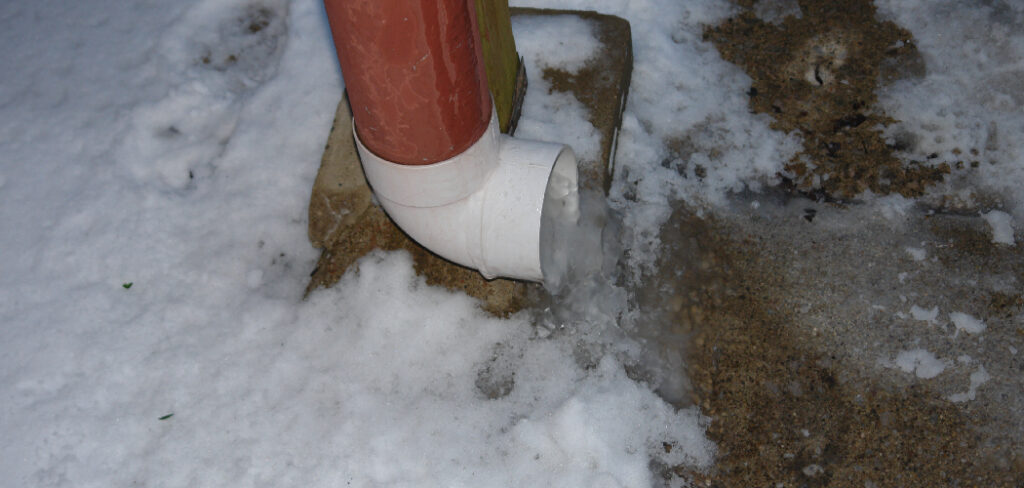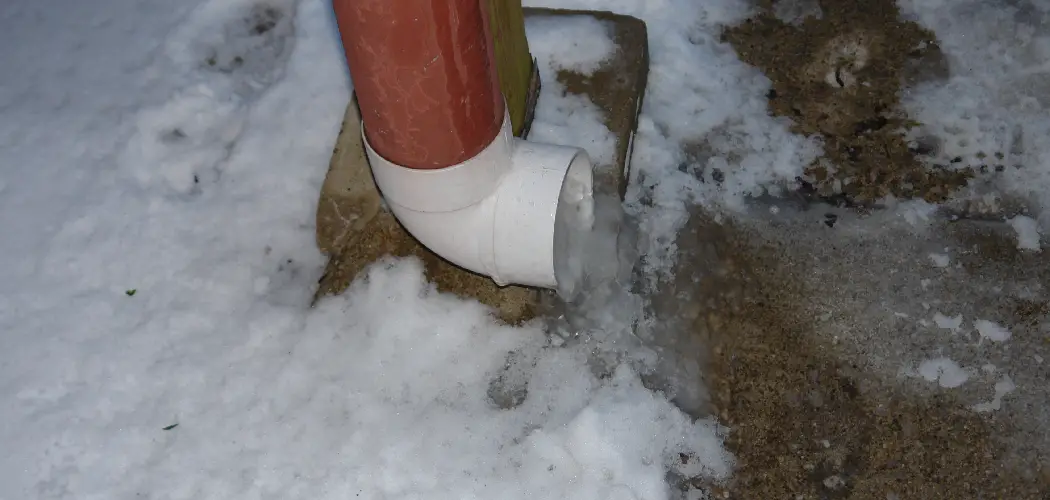If you’re a homeowner, one of the most important aspects of preventative maintenance is keeping your underground pipes from freezing. In many parts of the country, winter brings sub-zero temperatures that can cause severe damage to any exposed plumbing and related infrastructure.

Fortunately, with proper care and preparation, it’s possible to keep those underground drainage pipes safe during the colder months so you can avoid costly repair bills down the line.
In this blog post, we’ll explain why pipe freezing is a major problem for homeowners in cold regions and provide tips on how to keep underground drain pipes from freezing. So let’s get started – read on for more information about how you can keep your drainage pipes working properly year round!
7 Best Ways on How to Keep Underground Drain Pipes From Freezing
1. Install Heated Cables:
Installing heated cables is one of the most efficient and reliable ways to prevent underground pipes from freezing in cold climates. This type of cable wraps around the exterior of a pipe and creates just enough heat to keep it functioning properly, even at temperatures as low as -20 degrees Fahrenheit.
2. Use Insulation:
Using insulation around your pipes is a cost-effective way to prevent freezing. You can buy pre-made pipe insulation kits, or you can use foam sleeve wraps that have been specifically designed for underground pipes. This type of insulation will help keep warm air inside the pipe, making it less susceptible to freezing.
3. Apply Waterproofing Materials:
One of the key causes of pipe freezing is when moisture enters and accumulates in a pipe, creating pockets of cold air that can freeze. To combat this, you should apply waterproof materials to the exterior of your pipes. This will help create a barrier against moisture and keep your pipes safe from freezing temperatures.
4. Properly Heat Your Home:
Proper heating of your home is one of the best ways to prevent your underground pipes from freezing. Make sure that all areas of your house are kept warm throughout the winter months, as this will help keep those buried pipes safe and secure. Keeping your home heat will require a significant investment, however, it is often well worth the cost.
5. Keep the Heat On:
When temperatures drop significantly, try to keep some heat running in your home even when you’re not there. This will help maintain an ambient temperature that should keep your underground pipes from freezing. If you are away from home for long periods of time, you should consider setting your thermostat to at least 55°F.
6. Use Anti-Freeze:
Using a non-toxic anti-freeze in your pipes is another simple and effective way to keep them from freezing. There are many brands available that are specifically designed to guard against freezing temperatures. Be sure to check the label for instructions on properly using the anti-freeze in your pipes.
7. Dig Deeper:
If you’re looking for more extreme measures, consider digging deeper and installing your underground pipes at a greater depth below grade. Doing so will help protect them from the cold air that settles near the surface and will help keep your pipes functioning safely throughout the winter months.
By following these tips, you can help ensure that your underground drain pipes remain in great condition despite cold temperatures. Proper maintenance and preparation can prevent costly repair bills resulting from frozen or damaged plumbing. Be sure to review your pipes regularly, especially during the winter months, to ensure that they remain in working order.
Additional Tips and Tricks to Keep Underground Drain Pipes From Freezing
- Make sure to properly insulate all exposed pipes going underground with foam pipe insulation, especially near areas where cold air might be able to get in, like around windows and doorways.
- Check your home’s foundation for cracks or gaps that may allow cold air to pass through, and seal them with caulk or expanding foam insulation.
- If you can access your underground drain pipes, use heat cables or heating tape wrapped around the pipe to keep them from freezing. Make sure to use a thermostat that is designed for this purpose and follow all manufacturers’ instructions when using these products.
- Ensure all outdoor faucets and any piping connected to them are also insulated to prevent freezing.
- During cold spells, keep your home’s thermostat set at a higher temperature than usual, as this will help keep the area around the pipes from becoming too cold.
- If you have access to a generator, use it to provide some heat and electricity to areas where underground pipes may be located. This will help keep these areas from getting too cold.
- Have your underground drain pipes inspected regularly by a professional plumber to ensure they are in good working condition and not likely to freeze up during cold months.
- Make sure to keep all underground piping well-maintained and free from any debris that could restrict water flow or cause freezing. Clean out your pipes regularly using a pipe auger or hydro jetting service.
- If you have an irrigation system, make sure to winterize it by turning off the water supply and draining any remaining water out of the system before cold temperatures set in. This will help prevent the pipes from freezing and bursting during winter.
- If your home is located in an area with extreme temperatures, consider installing a hot water recirculating system that will keep warm water circulating through underground drain pipes even when it’s cold outside.

This will help to keep them from freezing up in the winter months.
Following these tips and tricks can help to ensure that your underground drain pipes remain free from freezing during the cold winter months. Additionally, having a licensed plumber inspect your home’s drainage system regularly can help you catch any potential issues before they become major problems. Taking proactive steps now will save you time and money and prevent potential damage to your home or property.
Frequently Asked Questions
What Are Some Ways to Prevent Underground Drain Pipes From Freezing?
Several methods can be used to protect underground drain pipes from freezing. These include wrapping the pipe in insulation, using heated cables, installing a sump pump with a discharge line, and keeping the area around the pipe clear of debris or mulch that could insulate it and cause freezing. Additionally, maintaining a consistent temperature in the area around the pipe can help to prevent freezing.

What Are the Consequences of Frozen Underground Drain Pipes?
Frozen underground drain pipes can lead to a variety of problems, such as bursting or leaking pipes, plumbing system malfunctions, and costly repairs. In addition, they can lead to flooding of the area around the pipe and damage to property.
What Should I Do if My Underground Drain Pipes Have Already Frozen?
If your underground drain pipes are already frozen, it is important to act quickly in order to avoid further damage. One way to thaw a frozen pipe is to use hot water or an electric heating pad wrapped around the pipe.
However, if you cannot thaw the pipes yourself, it is advised to call a professional plumber for assistance. Additionally, it is important to fix any underlying issues that may have caused the pipes to freeze in the first place.

What Can I Do After My Underground Drain Pipes Have Frozen?
Once your underground drain pipes have been thawed, it is important to take preventative measures in order to avoid the same issue from occurring again. The best way to do this is by following the methods mentioned earlier in this article, such as wrapping the pipe in insulation and maintaining a consistent temperature around the pipe.
Additionally, it is important to regularly clean the area around the pipe to prevent any debris or mulch from insulating it and causing a freeze. Taking these steps will help ensure that your underground drain pipes are protected from freezing in the future.
What is the Best Way to Protect Underground Drain Pipes From Freezing in the Future?
The best way to protect underground drain pipes from freezing in the future is by taking preventative measures such as wrapping the pipe in insulation, using heated cables, installing a sump pump with a discharge line, and keeping the area around the pipe clear of debris or mulch that could insulate it and cause freezing.

Additionally, maintaining a consistent temperature in the area around the pipe can help to prevent freezing. It is also important to regularly clean the area around the pipe to prevent any debris or mulch from insulating it and causing a freeze. Taking these steps will help ensure that your underground drain pipes are protected from freezing in the future.
Conclusion
Knowing how to keep underground drain pipes from freezing is essential to avoid costly repairs and damage to property. Preventative measures include wrapping the pipe in insulation, using heated cables, installing a sump pump with a discharge line, and keeping the area around the pipe clear of debris or mulch that could insulate it and cause freezing, you can avoid frozen pipes in the future.
Additionally, it is important to regularly clean the area around the pipe and maintain a consistent temperature in the area. Taking these steps can help ensure that your underground drain pipes are protected from freezing in the future.
About
Outdoor Fixes is a distinguished figure in the world of Diy design, with a decade of expertise creating innovative and sustainable Diy solutions.
His professional focus lies in merging traditional craftsmanship with modern manufacturing techniques,
fostering designs that are both practical and environmentally conscious. As the author of diy,
outdoorfixes delves into the art and science of outdoorfixes-making, inspiring artisans and industry professionals alike.
Education RMIT University
(Melbourne, Australia) Associate Degree in Design (Outdoor Fixes) Focus on sustainable design, industry-driven projects,
and practical craftsmanship. Gained hands-on experience with traditional and digital manufacturing tools, such as CAD and CNC software.
Nottingham Trent University
(United Kingdom) Bachelor’s in outdoorfixes.com and Product Design (Honors) Specialized in product design with a focus on blending creativity with production
techniques. Participated in industry projects, working with companies like John Lewis and Vitsoe to gain real-world insights.
Publications and Impact
In diy, Outdoor Fixes his insights on indoor design processes, materials, and strategies for efficient production.
His writing bridges the gap between artisan knowledge and modern industry needs, making it a must-read for both budding designers and seasoned professionals.

